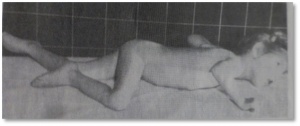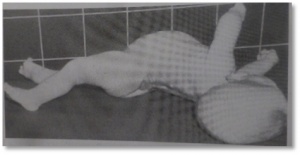Development of the Child with Cerebral Palsy
Original Editor - Lorena Perez as part of ICRC Cerebral Palsy Content Development Project
Top Contributors - Naomi O'Reilly, Kim Jackson, Simisola Ajeyalemi, WikiSysop, 127.0.0.1, Tony Lowe, Rucha Gadgil, Lucinda hampton, Jess Bell and Chelsea Mclene
Introduction[edit | edit source]
Knowledge of typical development is essential to compare the atypical development of children with Cerebral Palsy at all stages of their development, but even more so during the early stages where imparments are often not so evident
http://www.cdc.gov/ncbddd/actearly/milestones/index.html
Depending on the type of the Cerebral Palsy and Neurodevelopment Disorders, we will observe different patterns including positions and movements and different impairments.
The symptoms and function of each person with Cerebral Palsy varies. Cerebral Palsy is non-progressive so does not get worse over time, but the exact symptoms and function can change over a person's lifetime. From Birth to 5 years of age, a child should reach specific movement goals or developmental milestones - e.g. rolling, sitting up, standing, and walking which are often delayed or absent in the child with Cerebral Palsy.
Lets examine the development related to each type of Cerebral Palsy. Different body systems can influence the development milestones in children with Cerebral Palsy.
Musculoskeletal System:[edit | edit source]
Bony structures deformities or impairments are secondary due to:
- Impact of gravity on a body that has poor alignment and moves abnormally
- Abnormal muscle contraction during growth
- Lack of variety of movements and strategies e.g. weight-bearing postures.
Neuromuscular System;[edit | edit source]
In relation to Spasticity and Muscle Fibre, the literature supports the notion that, although spasticity is multifactorial and neural in origin, significant structural alterations in muscle also occur. An understanding of the specific changes that occur in the muscle and extracellular matrix may facilitate the development of new conservative or surgical therapies for this problem. ( see Annexe 1)
Sensory and Perceptual System;[edit | edit source]
In many children with Cerebral Palsy vision is compromised in relation to postural control and movement, proprioceptive, tactile and vestibular functioning, which creates pathologic patterns and strategies to move and orient the body in space.
Respiratory System:[edit | edit source]
Many children with Cerebral Palsy have difficulty to maintain respiration while at the same time supporting posture and movement. Infants breathe primarily with the diaphragm which sits high in the thoracic ribcage, with each inspiration, it contracts, pushing down on the abdominal contents. In the infant, the abdominal muscles are not yet working to oppose this force of the diaphragm, and the belly expands. This is called belly breathing. In addition the ribcage is elevated and the ribs horizontally positioned, making the ribcage a fairly rigid structure. This is why the ribcage remains elevated and the spine in flexion in many children with Cerebral Palsy. They have difficulty to expand the rib cage for air exchange and difficulties in exhalation of air to control the speech. The abdominal muscles fail to be used posturally to support lower trunk stability in children with Cerebral Palsy.
Associated Conditions:[edit | edit source]
Other impairments that children with Cerebral Palsy can develop are skin and digestion problems, motivation, nutrition and growth, deficit of attention, learning difficulties. You can read more about these conditions on the Physiopedia Page Cerebral Palsy Associated Conditions.
Typical Postures and Movement Strategies[edit | edit source]
This information is based on clinical observation and clinical reasoning from the evaluation and assessment of the impairments, and describes the atypical features for children with spasticity, athetosis, hypotonia and ataxic cerebral palsy.
Quadriplegia[edit | edit source]
| Upper Limb Observation | Lower Limb Observation |
|---|---|
|
Neuromuscular System:
|
Neuromuscular System:
|
|
Musculoskeletal Feature: The child will adopt pathologic patterns in the attempt to see or play:
Note: This pattern will correspond to a kid with a normal development of 1 month, but babies developing normally change this position by controlling the head with in 3 planes; extension, flexion, lateral flexion and rotation while pushing the surface against gravity. |
Musculoskeletal Feature:
|
Recent Related Research (from Pubmed) [edit | edit source]
Extension:RSS -- Error: Not a valid URL: Feed goes here!!|charset=UTF-8|short|max=10
References [edit | edit source]
References will automatically be added here, see adding references tutorial.








